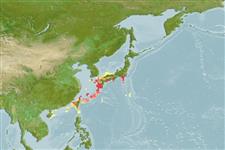>
Mulliformes (Goatfishes) >
Mullidae (Goatfishes)
Etymology: Upeneus: Greek, ypene, -es = upper lip (Ref. 45335); itoui: Named for Mr. Masahide Itou who collected almost all Kagoshima specimens of the new species and kindly made them available to the authors. Sakuya-himeji and Oriental Goatfish are herein proposed as the standard Japanese and English names, respectively, for the species (Ref. 88711).
Eponymy: Mr. Masahide Itou is a Japanese ichthyologist based in Kagoshima, Kyushu, Japan. He collected specimens of this goatfish and made them available to the authors. (Ref. 128868), visit book page.
Issue
FishBase common name changed from Oriental goatfish to Itou's goatfish (Uiblein et al., 2024: Ref. 130857).
Environment: milieu / climate zone / depth range / distribution range
экология
морской демерсальный; пределы глубины 23 - 27 m (Ref. 88711). Tropical
Northwest Pacific: southern Japan.
Size / Вес / Возраст
Maturity: Lm ? range ? - ? cm
Max length : 12.3 cm SL самец/пол неопределен; (Ref. 88711)
Краткое описание
определительные ключи | морфология | морфометрия
колючие лучи спинного плавника (общее число) : 7; членистые (мягкие) лучи спинного плавника (общее число) : 9. A species of Upeneus with the following combination of characters: dorsal-fin rays VII + 9, first dorsal-fin spine longest; pectoral-fin rays 13–15 (usually 14); gill rakers 6 or 7 (mode 6) + 16–18 (17) = 22–25 (23); pored lateral-line scales 28–30 (29); no teeth on ectopterygoids; maximum body depth 20.9–24.7% SL (mean 22.7%); maximum head depth 18.0–20.6% SL (19.2%); barbel width 6.0–7.8% HL (7.0%); barbels white; a distinct reddish brown stripe from tip of snout to caudal-fin base through eye in life and fresh specimens; first dorsal fin with 4 irregular white bands in life, 4–6 irregular reddish brown bands (retained as dark bands in preserved specimens) and 4–6 white bands in fresh specimens; upper caudal-fin lobe pale white with 5–7 reddish brown bands (retained as dark bands in preserved specimens) and 5–9 irregular pure white bands in life and fresh specimens; lower caudal-fin lobe reddish with 5–9 short red bands (retained as dark bands in preserved specimens) and 5–9 short white bands or spots along ventral margin in life and fresh specimens (Ref. 88711).
Life cycle and mating behavior
половая зрелость | размножение | нерест | икра | Fecundity | личинки
Yamashita, M., D. Golani and H. Motomura, 2011. A new species of Upeneus (Perciformes: Mullidae) from southern Japan. Zootaxa 3107:47-58. (Ref. 88711)
Статус Красного Списка МСОП (Ref. 130435: Version 2024-1)
Угроза для людей
Harmless
Использование человеком
дополнительная информация
инструменты
Специальные отчеты
Скачать в формате XML
ресурсы в Интернет
Estimates based on models
Phylogenetic diversity index (Ref.
82804): PD
50 = 0.5000 [Uniqueness, from 0.5 = low to 2.0 = high].
Bayesian length-weight: a=0.00933 (0.00439 - 0.01983), b=3.09 (2.92 - 3.26), in cm total length, based on LWR estimates for this Genus-body shape (Ref.
93245).
Trophic level (Ref.
69278): 3.4 ±0.4 se; based on size and trophs of closest relatives
устойчивость к внешним воздействиям (Ref.
120179): высокий, минимальное время удвоения популяции до 15 месяцев (Preliminary K or Fecundity.).
Fishing Vulnerability (Ref.
59153): Low vulnerability (10 of 100).
